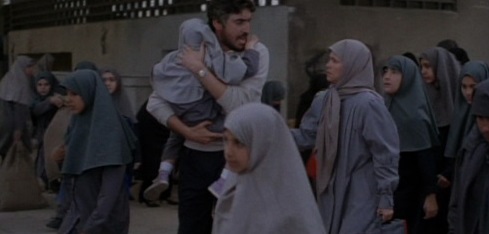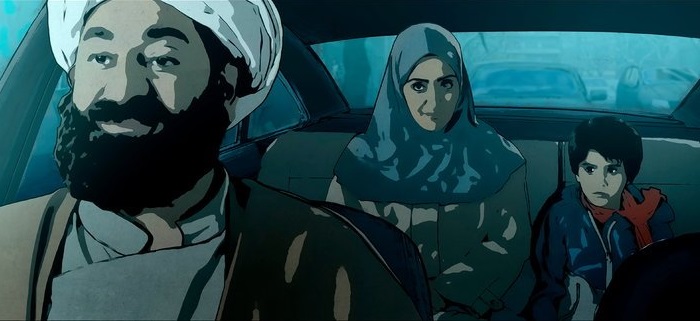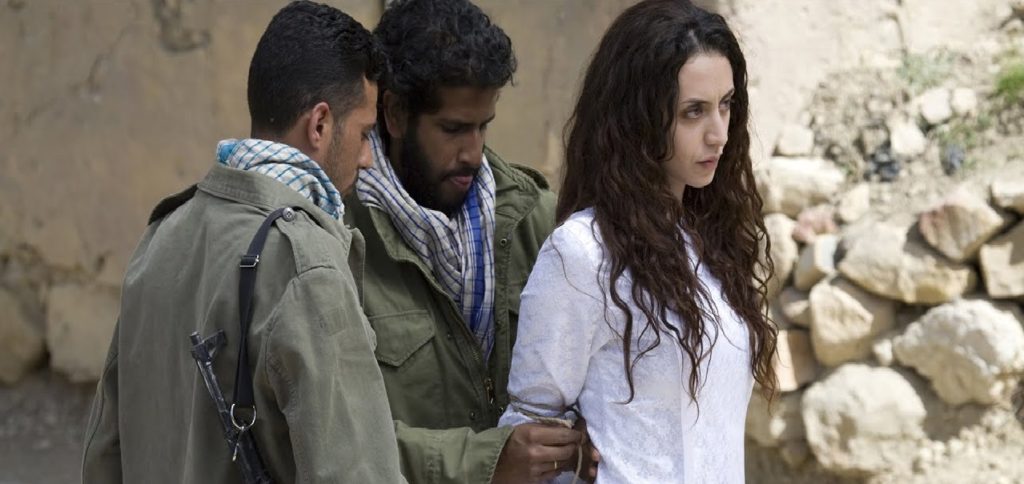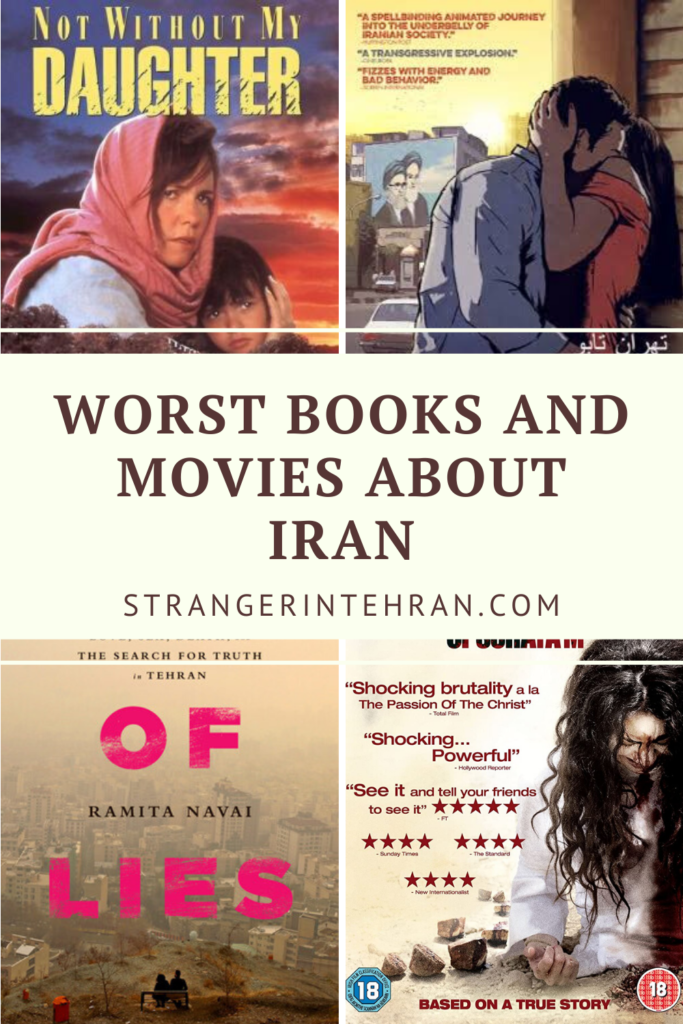
Worst Books and Movies About Iran
Iranians constantly blame Western media that they are showing only the negative side of Iran creating a very dark perception of Iran in the world. However, I believe that the worst damage to the image of Iran is done by Iranians themselves. Many books and movies about Iran created in the West, are created by Iranians who fled the country due to political reasons or limitations or whatsoever. And what do they talk about? Of course, the hard times they had in Iran. I realize that these things must be said as well. But it hurts me when these films and books make a way greater impression on the audience than what is good and positive is there about Iran.
In this post, I am going to introduce several books and films that would ruin any positive thoughts you had about Iran. So please, please, please, if you decide to watch or read any of these, take it with a pinch of common sense! I have written this post to just warn you that people`s stories are very subjective and prejudiced, and especially when they are told with the help of art. And here are a few stories that are probably not the best sources if you are willing to expand your general knowledge about Iran.
Not Without My Daughter
This book by Betty Mahmoody and William Hoffer published in 1987 tells the true personal story of Betty Mahmoody and her bitter marriage to an Iranian. This is the only book on the list written by a non-Iranian (Betty Mahmoody`s American).
The book starts with a beautiful story of Betty`s falling in love with an Iranian, marrying him and giving birth to their daughter. Although, this story doesn`t end with “…and they lived happily ever after”. When Betty`s daughter Mahtob turns 5, Betty`s husband offers to take a two-week trip to Tehran to let their daughter meet her Iranian relatives. And here the problems start. Betty is shocked by the things she sees around her and the conditions she has to stay in, she is experiencing a terrible cultural shock.

In Tehran she faces a traditional, religious family, sees how her father`s father wakes up the whole family for morning prayer, and is shocked that her husband joins them. Throughout the book, she keeps repeating that her Iranian husband turned into a totally different person as soon as they entered his parents` house.
All of a sudden, her husband`s character starts to change to the extent that he hits her. Betty`s whole world is breaking into pieces when he suggests they stay longer, and when Betty disagrees, he offers her to go back to the US, but without her daughter.
The further I went through the book, the more I wondered how a woman can marry a person, especially with a foreign background, without even bothering to learn a thing or two about his culture. How can a woman marry a man without meeting his family and finding out about his roots? I mean, we don`t choose our parents but to a large extent, it`s them who form our personality.
Not Without My Daughter was followed by the same-name movie partially filmed in Israel (what a coincidence!) and released in 1991. But of course, if you want to get the full image of all misfortunes that happened to Betty in Iran, read the book first.
It`s only natural that Betty`s husband, Sayyed Bozorg Mahmoody, decided to show what happened from his perspective. In 2002, a documentary called Without My Daughter was made showing Mahmoody`s efforts to reach out to his daughter. He also wrote a book called Lost Without My Daughter.
And now the daughter. In 2015 Mahtob Mahmoody published her memoir My Name Is Mahtob showing her perspective of the events. However, none of the later books or films have become as popular as the film based on the original book. And unfortunately, many people still watch Not Without My Daughter and what they conclude from it doesn`t show the whole picture. After all, stories with a happy ending never make a bestseller.
Tehran Taboo (2017)
There has always been something innocent about animations to me. However, after watching Tehran Taboo I realized that animations can be quite unpleasant too.
Tehran Taboo was directed by Ali Soozandeh and produced in Germany and Austria. It depicts sexuality and gender issues that young Iranians experience nowadays. It tells the stories of three women – a prostitute who becomes a mistress of a mullah, a pregnant woman who wants to work but her husband is against it fearing another miscarriage, and a young girl who loses her virginity to a random guy she meets at a party but suddenly realizes that she may get into trouble because she`s getting married soon.

The film is pretty harsh – you will see multiple sex scenes and public executions but that`s not my main argument against it. In interviews, Soozandeh says that by making this film he is trying to trigger a positive change in modern Iranian society. But he forgets one thing. The major audience of the film are foreigners and Iranian diaspora outside Iran. It means that an ordinary Iranian family will hardly hear of it. These issues are tightly connected to Iranian culture which has been intertwined with the religion for centuries, they are so deeply rooted that a change can`t be made by such a thing as a movie. This struggle between traditionalism and modernism has been going on in Iran for a century and it`s impossible to change the way people think overnight.
Personally, I`m really interested in this issue and if you are too, don`t hesitate to drop me a line, I`d be delighted to discuss it with you.
City of Lies: Love, Sex, Death, and the Search for Truth in Tehran
City of Lies, a book by Ramita Navai, to some extent resembles Tehran Taboo. There are even scenes which can be seen in both of them. However, the level of disgust that City of Lies provokes in readers is much, much, much higher. Several times while reading the book I wanted to stop, close the book, delete it from my phone and forget that I ever opened it. But then I would think that how would I write a review if I don`t read all of it.
Do you like conspiracy theories? Do you like stories about the mafia, prostitutes, drug dealers, and sodomy? With tons of juicy details? Oh, then you`ll love City of Lies! Ramita is doing her best to persuade non-Iranian readers that Iran is no different from any other country, that Iranians drink, have premarital sex, use drugs, and do many other things just like many other people all over the world. But you know what impression does the book make? You`ll think that every Iranian is either a prostitute, a gay, a drug addict, or an alcoholic. You`ll think that in Iran no man is faithful to his wife – neither religious clerics nor modern young people.
One review on the book says,
‘The funny thing is: in the end, after all the craziness, the suffering, the repression and absurdity, after a stoning and a case of abuse, drug crime and several unhappy marriages, you nevertheless feel quite enamoured with this city’. (Qantara)
I say, in the end, you will feel disgusted and would never want to travel to a city like that because you would never feel safe in it and would constantly look out something like that happening to you.
Navai`s stories are a collage of the most terrible, frightening, disgusting things that had ever happened in Tehran. Of course, all of them can easily be true (although Iran is changing constantly, and some details seem outdated already), but when all of them take place in one book beside each other when there is nothing else in it, but then, does it really show the real face of Tehran? I wouldn`t say so. I would say that it shows the life of just a small percent of Tehran`s population. Having lived in Tehran for years, I know what I am talking about. Yes, Tehranis are very similar to people in many other countries, but in a totally different way. They want to start a family and have children, they want to succeed at what they do, they care for their family, and they love having fun.
I knew someone whose most fascinating experience from his trip to Iran was a kiss from an Iranian girl. I knew people who would look for local vodka so that they could tell their friends later that they drank in a country where alcohol is prohibited. But to be honest, I don`t want people to travel to Iran to have a sense of danger, have some adrenaline running in their veins.
Stoning of Soraya M. (2008)
This film is probably the most famous American film about Iran. It is based on the book La Femme Lapidée by French-Iranian journalist Freidoune Sahebjam who was traveling in Iran in 1986 when his car breaks down near a remote village. That`s where he meets a woman who tells him the story of her niece`s cruel murder and asks him to tell the world about this injustice. He keeps his word and writes a book based on a true story (as he claims). The book was then adapted to a screenplay and made into a movie by American-born Cyrus Nowrasteh and his American wife.
The most important thing you need to know about the film is that it`s extremely brutal. Be prepared to watch how people are throwing stones into a bleeding woman dug into the ground for 20 (!) minutes. But let me tell you why she was stoned in the first place.

A man decides to marry a teenage girl and wants to get rid of his current wife, Soraya. In case of a divorce, he still would have to pay her, so he comes up with another way to both get rid of his wife and avoid paying anything to her – he decides to accuse her of adultery. And for that, he needs 4 male witnesses who could have caught her at the act of adultery. Of course, Soraya is a faithful wife, so he has to push four people to testify against Soraya.
Stoning as a capital punishment can be traced back to ancient Greece. It also appeared in Judaism. In Iran, it seems, stoning came into use only after the Islamic Revolution. And fortunately, in 2013 it was banned in Iran after Stoning of Soraya M. was released and drew a lot of attention to this problem worldwide.
I can`t deny that the whole idea of stoning is horrible, and I am impressed by how one film can change the laws. But it hurts to see that for most people who have seen the movie, stoning will always be associated with Iran.
Final Word
The reason why I have written this post is that Iran is an amazing country 100% worth visiting and it hurts me when I see Iranians completely ruining the image of the country. Personally, I understand their reasons and I`m not saying that they are lying. Bad things happen everywhere, but just in different shapes, and luckily, I know Iran well enough to realize that Iran is not limited to what is shown in these books and movies. But there are so many people out there who haven`t even been to Iran and will believe whatever you tell them about Iran.
Many Iranians are trying hard to raise awareness about Iran around the globe, but sometimes they just miss the aim and worsen the things. If you are a foreigner and you are interested in Iran, please be careful with choosing the sources you get information from. Always do some research about the creators to get their background and viewpoint, and always keep in mind that whatever you saw, read, or heard, Iran is not just it – to every negative thing, there is a positive one. And in my future posts, I`ll share books and films that will give a more realistic image of life in Iran.
Have you seen any movies, books, or other sources that in your opinion misinterpret Iran? What books and films would you recommend instead?


